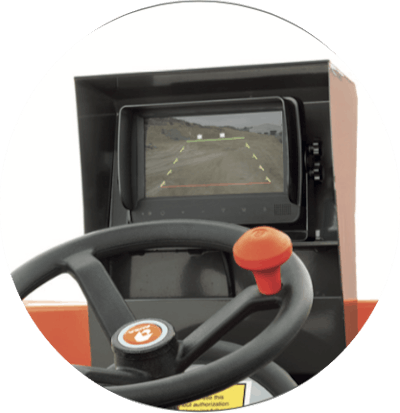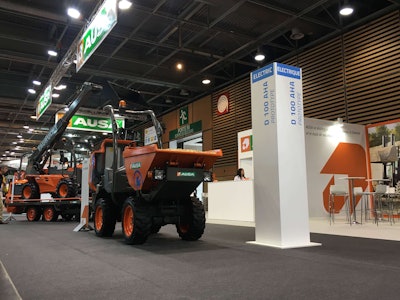 AUSA D601AHG dumper
AUSA D601AHG dumper Display on the AUSA D601AHG dumper.
Display on the AUSA D601AHG dumper.With a 13,200-plus pound load capacity, the new 74-horsepower D601AHG site dumper from AUSA features telematics and what the company calls a Full Visibility System. AUSA says the machine is “the first hydrostatic dumper with a limited-slip differential on both axles,” a feature that gives it all-terrain traction.
The company’s Full Visibility System on the D601AHG uses 32-foot-range front and rear cameras with infrared night vision, along with eight 6.5-foot-range proximity sensors (four in the front and four in the back). An in-cab 7-inch digital display shows obstacle distance indications; the system also issues audible warnings.
The display also provides key machine operating information, including fluid level indicators, engine diagnostics, rpms, speed and light.
The dumper incorporates three automatic operating modes: ECO Mode, which regulates the engine to maximize fuel efficiency; Start&Stop, which switches the engine off when it’s not in use; and Transport Mode, which allows increased engine power for higher speeds.
Large steps give the machine additional accessibility. LED lights are standard.
AUSA currently has five U.S. dealers, including two Toyota Lift Northwest locations in Kent, Washington, and Clackamas,Oregon; Best Supply, Wichita, Kansas; Boyer Incorporated, Houston, Texas; Rendels GMC, Joliet, Illinois; and Blakley Equipment, Mt. Vernon, New York.
Electric dumper
 AUSA D100HHA electric dumper prototype, as shown at the recent Intermat show in Paris.
AUSA D100HHA electric dumper prototype, as shown at the recent Intermat show in Paris.At the recent Intermat show, AUSA showcased its D100AHA electric prototype dumper, which it says is the first electric dumper with a cab.
The 13-kilowatt compact dumper can operate for 6 hours at maximum power, giving the machine a full-day’s power during typical use.
The 1-ton-capacity machine can be connected to a 220-volt outlet, and can be recharged in 5 hours.










